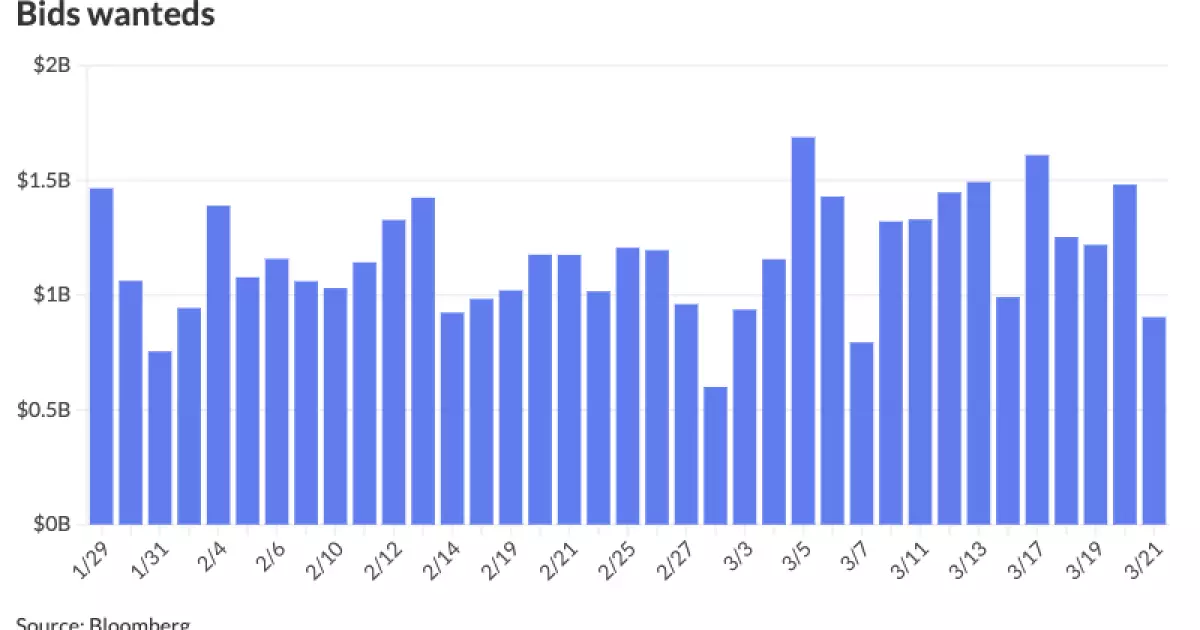5 Unmistakable Truths About the Municipal Bond Market’s Fragility

The municipal bond market is grappling with notable weaknesses as the U.S. Treasury yields tick upward and equities show resilience. The complexities that govern this financial area have left many investors bewildered, resulting in a fluctuating market sentiment. The recent numbers provided by Municipal Market Data show a worrisome decline in ratios across various maturities, reflecting deeper systemic issues rather than simply temporary volatility. Such a scenario compels investors to critically assess whether the current dynamics are a harbinger of long-term instability or merely the market’s response to external economic pressures.
The ratios indicate a declining attractiveness of municipal bonds when measured against their U.S. Treasury counterparts. Specifically, metrics like the two-year ratio at 66% and the 30-year ratio at 89% signal that investors are becoming wary, leading many to reconsider their positions in this asset class. Birch Creek strategists speculate that this erosion in performance is tied up with an aggressive new issuance of bonds and inherent Treasury volatility, both of which threaten to suffocate investor confidence even further. Therefore, what is at stake isn’t just the immediate yield, but rather a potential long-term stagnation in the municipal sector.
The Turbulent Investment Climate
Investor sentiment is affected by a dual-edged sword: increased offerings and escalating yields. The data indicates a staggering outflow of $216.4 million from municipal mutual funds last week, which underscores that investors are increasingly pulling away from bonds in search of better yields elsewhere. This response is particularly disheartening, especially as it happens during tax season, a time when bonds typically gain traction due to their tax-exempt status. How can one not be alarmed by such a trend? Municipal bonds are traditionally considered a safe harbor, yet we are witnessing a departure reminiscent of ships fleeing a sinking vessel.
Moreover, while some strategists argue that the recent supply constraint of approximately $7.9 billion this week offers a glimmer of hope for municipal performance, it’s hard to shake the feeling of impending doom that hangs over the market. The alluring valuations across the curve, while seemingly promising, become less significant when weighed against the persistent headwinds caused by rate volatility. Investors might find the thought of “waiting it out” increasingly untenable, as three-to-six months of potential gains vanish under the specter of weakening credit ratings and ever-increasing inflation.
Long-Term Trepidations and Valuations
The long end of the municipal curve has experienced some semblance of stability, with the 30-year after-tax spreads tightening slightly. Yet, any praise for this segment must be tempered by caution. Can we genuinely celebrate any sort of pronounced recovery when yields are still higher in most categories? Even amidst a momentary upward tick, one must question the sustainability of these gains in a climate rife with uncertainty. As Citi strategists suggest, the market could look attractive now, but will it last? The answer rests in the hands of factors that traditional models are struggling to encapsulate.
This begs an evident question: Are investors foreseeing a prolonged period of underperformance? The recent performance stagnation is likely to fuel ongoing discussions about credit quality and the viability of municipal bonds in uncertain economic climates. The rise in demand from buyers is encouraging, especially as noted purchases jumped by 20%; however, the enthusiasm may be short-lived if volatility in UST yields continues to dominate.
Navigating the Future of Municipal Financing
As cities and municipalities turn to the capital markets for financing, the looming specter of persistent underfunding continues to plague them. The upcoming $1.534 billion deal by the Los Angeles International Airport epitomizes this duality of need and risk. The larger question revolves around whether municipalities can weather this financial storm while simultaneously meeting the rising expectations from constituents and stakeholders.
The looming challenges faced by local governments will likely shape the future of municipal financing. If investors continue to abandon the asset class, municipalities may find themselves in a tight spot, forced to accept less favorable terms on bonds or, worse, lose access to necessary funding altogether. It’s a headache for the municipal market, a nosebleed for local administrations, and a growing concern for taxpayers.
In this urgent environment, conservative investors with an aptitude for active management could benefit from meticulously sifted opportunities while maintaining heightened awareness. The future of municipal bonds might well depend on how actively these various factors are monitored and managed, compelling investors to think critically about where they place their money in this tumultuous landscape.





